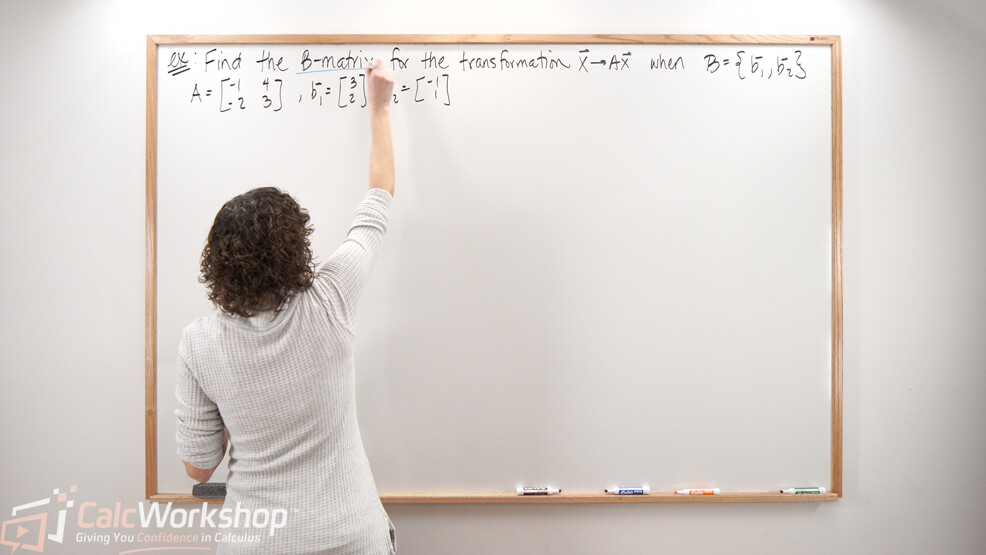What if we don’t want to map from \(\mathbb{R}^{n}\) to \(\mathbb{R}^{m}\) but instead, we want to find a representation for any linear transformation between two finite-dimensional vector spaces. To do this, we must combine powers: eigenvectors and linear transformations.

Jenn, Founder Calcworkshop®, 15+ Years Experience (Licensed & Certified Teacher)
If you may recall from our previous studies of transformations, if
\begin{aligned}
T: \mathbb{R}^{n} & \rightarrow \mathbb{R}^{m}
\end{aligned}
is a linear transformation, then there is an \(m \times n\) matrix \(\mathrm{A}\) such that
\begin{aligned}
\mathrm{T}(\mathrm{x}) & = Ax
\end{aligned}
for all \(\mathrm{x}\) in \(\mathbb{R}^{n}\), where
\begin{aligned}
A & =\left[\begin{array}{llll}T\left(\overrightarrow{e_{1}}\right) & T\left(\overrightarrow{e_{2}}\right) & \cdots & T\left(\overrightarrow{e_{n}}\right)\end{array}\right]
\end{aligned}
From Standard Basis to Coordinate Vectors
As we have seen, using the standard basis has been most convenient when performing a matrix transformation. But it comes up lacking when we want to map between vector spaces.
So, rather than using the standard basis, such that
\begin{aligned}
\vec{x} & \mapsto A \vec{x}
\end{aligned}
we will use the mapping
\begin{aligned}
\vec{u} & \mapsto D \vec{u}
\end{aligned}
which is essentially the same mapping just viewed from a different perspective.
How?
By representing vectors by their coordinate vectors for a basis!
Okay, let
\begin{aligned}
\mathrm{V} & \text{ be an } \mathrm{n}\text{-dimensional vector space,} \\
\mathrm{W} & \text{ be an m-dimensional vector space and } \\
\mathrm{T} & \text{ be the linear transformation from } \mathrm{V} \text{ to } \mathrm{W}
\end{aligned}
\begin{aligned}
T: V & \rightarrow W
\end{aligned}
Now, if
\begin{aligned}
B & =\left\{\vec{b}_{1}, \ldots, \overrightarrow{b_{n}}\right\}
\end{aligned}
be an ordered basis for \(\mathrm{V}\) and
\begin{aligned}
C & =\left\{\overrightarrow{c_{1}}, \ldots, \overrightarrow{c_{n}}\right\}
\end{aligned}
be the ordered basis for W, then we can express each vector \(\vec{x}\) in \(\mathrm{V}\) as a linear combination
\begin{aligned}
\vec{x} & =r_{1} \overrightarrow{b_{1}}+\cdots+r_{n} \overrightarrow{b_{n}}
\end{aligned}
for unique scalar weights \(r\).
Thus, we can represent the vector \(\vec{x}\) in \(\mathrm{V}\) by its coordinate vector in \(\mathbb{R}^{n}\) as
\begin{aligned}
[\vec{x}]_{B} & =\left[\begin{array}{c}
r_{1} \\
\vdots \\
r_{n}
\end{array}\right]
\end{aligned}
Likewise, we can represent each vector \(\vec{y}\) in \(\mathrm{W}\) by its coordinate vector
\begin{aligned}
[\vec{y}]_{C} & \text{ in } \mathbb{R}^{m}
\end{aligned}
Matrix Representation of a Linear Transformation
Therefore, if we want to find a \(m \times n\) matrix \(\mathrm{M}\) such that the linear transformation \(\mathrm{T}\) is equivalent to the coordinate vectors of \(M\) then
\begin{aligned}
[T(\vec{x})]_{C} & =M[\vec{x}]_{B}
\end{aligned}
where
\begin{aligned}
M & =\left[\left[T\left(\vec{b}_{1}\right)\right]_{C} \quad\left[T\left(\vec{b}_{2}\right)\right]_{C} \quad \cdots\left[T\left(\overrightarrow{b_{n}}\right)\right]_{C}\right]
\end{aligned}
The matrix \(\mathrm{M}\) is a matrix representation of \(\mathrm{T}\) and is called the matrix for \(\mathrm{T}\) relative to the basis \(\mathrm{B}\) and \(\mathrm{C}\).
Alright, this is great and all, but how does this really work? I’m confused.
Here’s how this work.
The Power of Diagonalization
In a problem involving \(\mathbb{R}^{n}\), a linear transformation \(T\) typically appears first as a matrix transformation. But if \(\mathrm{A}\) is diagonalizable, then there is a basis \(\mathrm{B}\) for \(\mathbb{R}^{n}\) consisting of eigenvectors of \(\mathrm{A}\). In this case, the B-matrix for \(\mathrm{T}\) is diagonal. Therefore, by diagonalizing \(\mathrm{A}\) we are in essence finding a diagonal matrix representation of \(\vec{x} \mapsto \overrightarrow{A x}\)
So, if \(A=P D P^{-1}\), as we learned in our Diagonalization video, where D is a diagonal \(n \times n\) matrix and if \(B\) is the basis for \(\mathbb{R}^{n}\) formed from the columns of \(P\), which represent the eigenvectors of \(\mathrm{A}\), then \(\mathrm{D}\) is the B-matrix for the transformation.
Example: Finding the B-Matrix with Eigenvectors
For example, suppose \(T: \mathbb{R}^{2} \rightarrow \mathbb{R}^{2}\) by
\begin{aligned}
T(\vec{x}) & =A \vec{x}
\end{aligned}
where
\begin{aligned}
A & =\left[\begin{array}{cc}2 & 7 \\ 1 & -4\end{array}\right]
\end{aligned}
Let’s find a basis B for \(\mathbb{R}^{2}\) with the property that the \(\mathrm{B}\)-matrix for \(\mathrm{T}\) is a diagonal matrix.
First, we know that
\begin{aligned}
A & =P D P^{-1}
\end{aligned}
so we will need to find our D matrix.
\begin{aligned}
\operatorname{det}\left[\begin{array}{cc}
2-\lambda & 7 \\
1 & -4-\lambda
\end{array}\right] & = 0 \\
(2-\lambda)(-4-\lambda)-7 & = 0 \\
\lambda^{2} + 2 \lambda – 15 & = 0 \\
(\lambda-3)(\lambda+5) & = 0 \\
\lambda & = 3, -5 \\
D & = \left[\begin{array}{cc}
3 & 0 \\
0 & -5
\end{array}\right]
\end{aligned}
Now we will find our \(P\) matrices consisting of the eigenvectors of \(A\).
\begin{aligned}
\lambda & = 3 \\\\
\left[\begin{array}{ccc}
2-3 & 7 & 0 \\
1 & -4-3 & 0
\end{array}\right] & = \left[\begin{array}{ccc}
-1 & 7 & 0 \\
1 & -7 & 0
\end{array}\right] \\
\sim\left[\begin{array}{ccc}
1 & -7 & 0 \\
0 & 0 & 0
\end{array}\right] & \Rightarrow \vec{x} = x_{2}\left[\begin{array}{c}
7 \\
1
\end{array}\right] \\\\
\lambda & = -5 \\\\
\left[\begin{array}{ccc}
2-(-5) & 7 & 0 \\
1 & -4-(-5) & 0
\end{array}\right] & = \left[\begin{array}{lll}
7 & 7 & 0 \\
1 & 1 & 0
\end{array}\right] \\
\sim\left[\begin{array}{lll}
1 & 1 & 0 \\
0 & 0 & 0
\end{array}\right] & \Rightarrow \vec{x} = x_{2}\left[\begin{array}{c}
-1 \\
1
\end{array}\right] \\\\
P & = \left[\begin{array}{cc}
7 & -1 \\
1 & 1
\end{array}\right]
\end{aligned}
Now, all that’s left is to recognize that the D matrix is the B-matrix in disguise!!!
It’s true! The D matrix is the B-matrix for \(\mathrm{T}\) when P represents the eigenvectors of \(\mathrm{A}\).
Awesome, right?
Example: Finding the B-Matrix with Given Matrices
Additionally, we can use A and P matrices to help us find our B-matrix.
Assume
\begin{aligned}
A & =\left[\begin{array}{cc}4 & -9 \\ 4 & 8\end{array}\right]
\end{aligned}
and
\begin{aligned}
\overrightarrow{b_{1}} & =\left[\begin{array}{l}3 \\ 2\end{array}\right]
\end{aligned}
and
\begin{aligned}
\overrightarrow{b_{2}} & =\left[\begin{array}{l}2 \\ 1\end{array}\right]
\end{aligned}
Let’s find our B-matrix.
Well, we’re given A and \(\mathrm{P}\), so what we need to find is \(\mathrm{D}\), which is really our B-matrix for the linear transformation.
\begin{aligned}
A & =\left[\begin{array}{cc}
4 & -9 \\
4 & 8
\end{array}\right]
\end{aligned}
and
\begin{aligned}
P & =\left[\begin{array}{ll}
\vec{b}_{1} & \overrightarrow{b_{2}}
\end{array}\right]=\left[\begin{array}{ll}
3 & 2 \\
2 & 1
\end{array}\right]
\end{aligned}
And if we resolve
\begin{aligned}
A & =P D P^{-1}
\end{aligned}
for \(\mathrm{D}\), which is our B-matrix, we get
\begin{aligned}
D & =P^{-1} A P
\end{aligned}
Therefore
\begin{aligned}
B-\text { matrix } & =P^{-1} A P \\
& =\underbrace{\frac{1}{-1}\left[\begin{array}{cc}
1 & -2 \\
-2 & 3
\end{array}\right]}_{P^{-1}} \underbrace{\left[\begin{array}{cc}
4 & -9 \\
4 & 8
\end{array}\right]}_{A} \underbrace{\left[\begin{array}{ll}
3 & 2 \\
2 & 1
\end{array}\right]}_{P} \\
& =\left[\begin{array}{cc}
-2 & 1 \\
0 & -2
\end{array}\right]
\end{aligned}
See, not so bad!
Next Steps
In this lesson, you will:
- Understand how diagonalization applies to linear transformation using coordinate vectors
- Learn how the matrix of a linear transformation associates with ordered bases \(\mathrm{B}\) and \(\mathrm{C}\)
- Discover how the matrix for \(\mathrm{T}\) relative to \(\mathrm{B}\) (B-Matrix) is used for transforming polynomials
- Make connections with the diagonal matrix representation and similar matrices, along with eigenvalues (D-Matrix or B-Matrix) and eigenvectors (P matrix or basis)
Dive in and start exploring!
Video Tutorial w/ Full Lesson & Detailed Examples

Get access to all the courses and over 450 HD videos with your subscription
Monthly and Yearly Plans Available
Still wondering if CalcWorkshop is right for you?
Take a Tour and find out how a membership can take the struggle out of learning math.